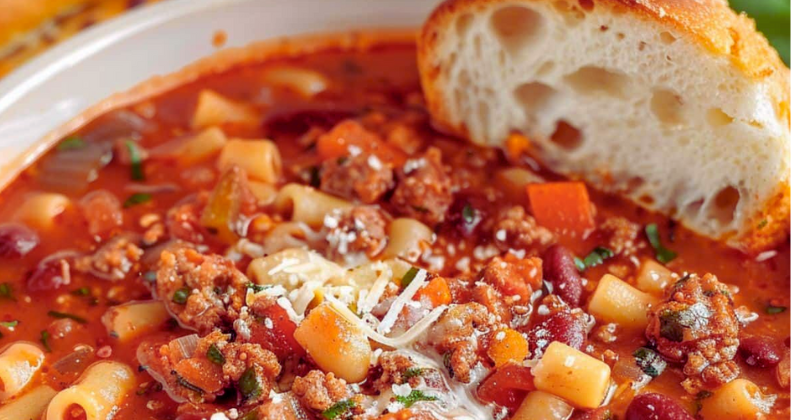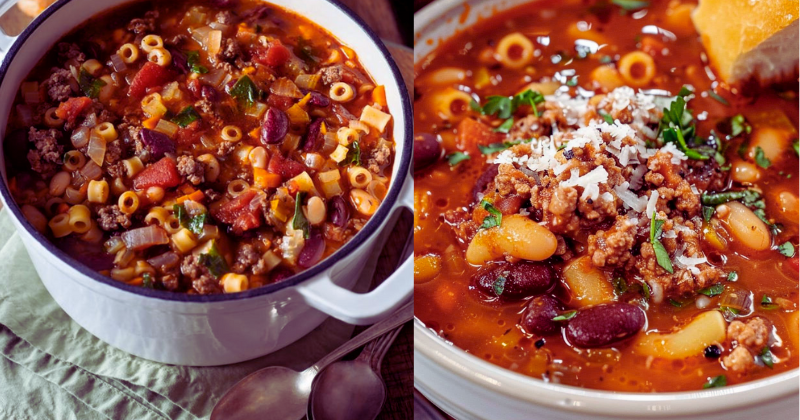Prep Time: 15 minutes | Cook Time: 45 minutes | Total Time: 1 hour | Serves: 6-8 | Difficulty: Easy
Table of Contents
There’s something magical about walking into Olive Garden and catching that first whiff of their famous Pasta e Fagioli soup. The rich, tomatoey broth mingling with herbs, the tender beans, and perfectly cooked pasta create an aroma that instantly transports you to comfort food heaven. I’ll never forget the first time my grandmother attempted to recreate this beloved restaurant favorite after my cousin raved about it for weeks. She spent an entire Sunday afternoon in her kitchen, determined to crack the code of this Italian-American classic. While her version was delicious, it took me years of experimentation to truly nail the authentic Olive Garden Pasta e Fagioli recipe that tastes just like the restaurant version. Now, I’m sharing all those hard-won secrets with you, so you can bring this heartwarming soup to your own dinner table without the wait or the restaurant bill.
Why You’ll Love This Recipe
This homemade Pasta e Fagioli will quickly become your go-to comfort food for busy weeknights and cozy weekends alike. First, it’s incredibly easy to make with simple, affordable ingredients you likely already have in your pantry – no specialty shopping required. The recipe is naturally family-friendly, appealing to both adults and picky eaters who love the familiar flavors of tomato and mild Italian seasonings. What makes this version truly special is how it captures that signature Olive Garden taste while being completely customizable to your family’s preferences. You can make it heartier with extra vegetables, lighter with more broth, or even transform it into a completely different meal with simple substitutions. Best of all, this soup actually tastes better the next day, making it perfect for meal prep and busy families who appreciate having delicious leftovers ready to go.
Ingredient Insights & Selection
The secret to authentic-tasting Pasta e Fagioli lies in choosing the right combination of ingredients that work together harmoniously. For the beans, I always use a mix of cannellini beans and red kidney beans – the cannellini provides creaminess while the kidney beans add color and a slightly firmer texture that holds up well during cooking. When selecting canned tomatoes, opt for high-quality crushed tomatoes rather than tomato sauce, as they provide better texture and more authentic flavor. The pasta choice is crucial: small shapes like ditalini or elbow macaroni work best because they’re easy to eat with a spoon and don’t overpower the other ingredients. For the meat component, lean ground beef is traditional, but ground turkey or Italian sausage make excellent substitutions. Fresh garlic and onions are non-negotiable – their aromatic foundation is what gives this soup its restaurant-quality depth. If you’re cooking for vegetarians, simply omit the meat and add an extra can of beans plus a splash of vegetable broth for richness. Always keep dried Italian seasoning, fresh basil, and good-quality olive oil on hand, as these ingredients elevate the soup from good to absolutely incredible.
Key Techniques & Method Overview
Mastering Pasta e Fagioli requires understanding four essential techniques that separate restaurant-quality soup from ordinary versions. First, proper sautéing creates the flavor foundation – you’ll want to cook your onions until they’re translucent and fragrant, then brown the meat thoroughly to develop rich, caramelized flavors that permeate the entire soup. The second crucial technique is building layers of flavor by adding ingredients in the right sequence, allowing each component to bloom and release its full potential before adding the next. Temperature control is your third key to success – maintaining a gentle simmer rather than a rolling boil prevents the beans from breaking apart and keeps the pasta from becoming mushy. Finally, timing is everything when it comes to adding the pasta. Unlike other soups where you can add noodles early, Pasta e Fagioli requires adding the pasta during the last 10-12 minutes of cooking to achieve that perfect al dente texture that won’t turn soggy when stored. Throughout the cooking process, taste and adjust seasonings frequently, as the flavors will concentrate and change as the liquid reduces. These techniques might seem simple, but executing them properly is what transforms basic ingredients into a soup that rivals your favorite restaurant version.

Step-by-Step Instructions
- Prepare your mise en place by dicing 1 large onion, mincing 3 cloves of garlic, and gathering all ingredients. Heat 2 tablespoons of olive oil in a large, heavy-bottomed pot over medium heat until it shimmers but doesn’t smoke.
- Build the flavor base by adding the diced onion to the hot oil and cooking for 5-6 minutes until translucent and fragrant. Add minced garlic and cook for another minute until aromatic – be careful not to let it burn.
- Brown the meat by adding 1 pound of lean ground beef, breaking it up with a wooden spoon and cooking for 6-8 minutes until completely browned and no pink remains. The meat should develop a nice caramelized color that adds depth to the soup.
- Add the tomato base by stirring in one 28-ounce can of crushed tomatoes, 2 tablespoons of tomato paste, and 4 cups of beef broth. The mixture should bubble gently when it reaches temperature.
- Season and simmer by adding 2 teaspoons Italian seasoning, 1 teaspoon salt, ½ teaspoon black pepper, and 1 bay leaf. Bring to a boil, then reduce heat to maintain a gentle simmer for 20 minutes, stirring occasionally.
- Add beans and pasta by stirring in one drained can each of cannellini and kidney beans, plus 1 cup of small pasta like ditalini. Continue simmering for 10-12 minutes until pasta reaches perfect al dente texture.
- Final touches include removing from heat, discarding the bay leaf, and stirring in 2 tablespoons of fresh chopped basil. Taste and adjust seasonings as needed before serving hot with crusty bread.
Pro Tips & Troubleshooting
The difference between good and exceptional Pasta e Fagioli lies in these insider secrets that professional cooks use. Always cook your pasta just shy of al dente if you plan to store leftovers, as it will continue cooking when reheated and won’t become mushy. For deeper flavor, add a parmesan rind during the simmering process – it infuses the broth with incredible umami richness that you can’t achieve any other way. If your soup turns out too thin, create a quick slurry by mashing half a cup of beans with a fork and stirring them back in, which naturally thickens the broth without adding flour. Conversely, if the soup becomes too thick, thin it with warm broth rather than water to maintain the robust flavor profile. The most common mistake home cooks make is adding too much pasta – remember that pasta absorbs liquid as it sits, so err on the side of less rather than more. If you accidentally oversalt the soup, add a peeled potato and simmer for 10 minutes to absorb excess sodium, then remove it before serving.
Variations & Customizations
Transform this classic recipe to suit your family’s preferences with these simple modifications. For a vegetarian version, omit the ground beef and add an extra can of beans plus diced mushrooms for meaty texture and umami flavor. Make it gluten-free by substituting your favorite gluten-free pasta shapes – just adjust cooking time according to package directions. Create a lighter version by using ground turkey instead of beef and adding extra vegetables like diced carrots, celery, and zucchini. For spice lovers, add red pepper flakes or a diced jalapeño when sautéing the onions. You can easily double or triple this recipe for meal prep or large gatherings – just use a bigger pot and extend cooking times slightly. Seasonal variations work beautifully too: add fresh spinach in spring, diced tomatoes in summer, or root vegetables in fall and winter.
Storage, Reheating & Make-Ahead Tips
Properly stored Pasta e Fagioli keeps beautifully and often tastes even better after the flavors have had time to meld. Refrigerate leftovers in airtight containers for up to 4 days, but note that the pasta will continue absorbing liquid, creating a thicker consistency. When reheating, add a splash of broth or water to restore the desired consistency and heat gently on the stovetop, stirring frequently to prevent sticking. For freezer storage, this soup keeps for up to 3 months, though the pasta texture may soften slightly upon thawing. To maintain the best texture, consider freezing the soup without pasta and adding freshly cooked noodles when reheating. For make-ahead convenience, prepare the entire soup except for the pasta up to 3 days in advance, then add and cook the pasta just before serving. This method ensures perfect texture every time while still saving significant prep time on busy weeknights.
Serving Suggestions & Pairings
Serve your homemade Pasta e Fagioli with warm, crusty Italian bread or garlic breadsticks for the full Olive Garden experience. A simple side salad with mixed greens, cherry tomatoes, and Italian dressing creates a perfectly balanced meal that won’t overpower the soup’s hearty flavors. For wine pairings, choose a medium-bodied red like Chianti or Sangiovese that complements the tomato base, or opt for a crisp white wine like Pinot Grigio if you prefer lighter accompaniments. Finish each bowl with a generous sprinkle of freshly grated Parmesan cheese and a drizzle of good olive oil for restaurant-worthy presentation. This soup also makes an excellent starter for Italian-themed dinner parties, followed by grilled chicken or fish with roasted vegetables. Consider serving it in bread bowls for a fun, interactive presentation that kids especially love.
Conclusion
Creating restaurant-quality Olive Garden Pasta e Fagioli at home is absolutely achievable with the right techniques and attention to detail. This recipe delivers all the comfort and satisfaction of the original while giving you complete control over ingredients and portions. The beauty of this soup lies not just in its delicious flavor, but in its versatility and ability to bring families together around the dinner table. Whether you’re cooking for a crowd or meal-prepping for the week ahead, this hearty soup will quickly become a treasured part of your recipe collection.
Ready to bring the warmth of Olive Garden’s kitchen to your home? Gather your ingredients and start simmering – your family is going to love this authentic recreation of their favorite restaurant soup. Don’t forget to save this recipe and share it with friends who appreciate good, homemade comfort food!

